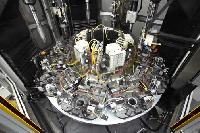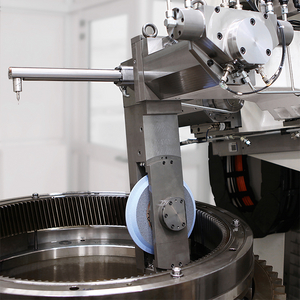Sunnen Plans Match Honing Demonstrations at IMTS

Sunnen's new match honing process produces bore specifications to match the measured size of individual pins, plungers or pistons that may have dimensional inconsistencies due to special plating, coating or other treatment. Match honing is a technology for achieving ultra-precise fit between mating parts of fuel injectors, piston pumps, cartridge valves and similar products that use coatings or other treatments on male component parts that make it impossible to achieve consistent diameter size. The process eliminates or reduces work-in-process inventories required when parts must be sorted by class size prior to assembly in order to achieve a precision fit. According to Sunnen, depending on the application, total tolerances between mating parts can be controlled to within ±1 micron with match honing, a process the company will demonstrate at IMTS on a three-spindle SV-1015 honing system.
The SV-1015 honing system uses integrated air gaging for closed-loop control of finished bore size to "match" the size of each male component that is measured on the machine immediately prior to the honing cycle. Using Sunnen's super abrasive MMT tool, the air-gage-equipped machine can automatically control hole size to accuracies of 0.1 µm (0.000010") without operator intervention, working in a size range of 3‑65 mm (0.120-2.56") diameter. The air gaging system controls bore dimensions and geometry by taking post-process measurements of the part bore immediately after each spindle, then adjusting the tool size in the next spindle.
The SV-1015 can also be equipped with Sunnen's optional new multi-feed technology, which gives honing process users a choice of tool-feed modes to achieve the shortest cycle times, lowest part cost, and longest abrasive life. Multi-feed combines Sunnen's new controlled-force tool feed with its standard controlled-rate tool-feed system. Controlled-force works like cruise control to ensure the optimum cutting load on the honing abrasive throughout a cycle. It cuts cycle times by as much as 50 percent, lengthens abrasive life for lower consumable cost, and allows finer control of surface finish parameters than ever before possible. The standard controlled-rate feed system for tool wear compensation is capable of adjusting tool size in increments as fine as 0.1 µm (0.000010"). Controlled-rate tool feeding is required for use with plated-diamond CGT honing tools, which use a sleeve of abrasive for full contact with the bore surface. CGT tools are frequently used on cast iron and powder metal workpieces, or parts with segmented bores or multiple lands, ports, keyways or crossholes in the bore. Sunnen's machine control provides up to five feed expansion profiles that can be used during a cycle for rapid part touch, cutting, sizing, finishing and spark-out.





